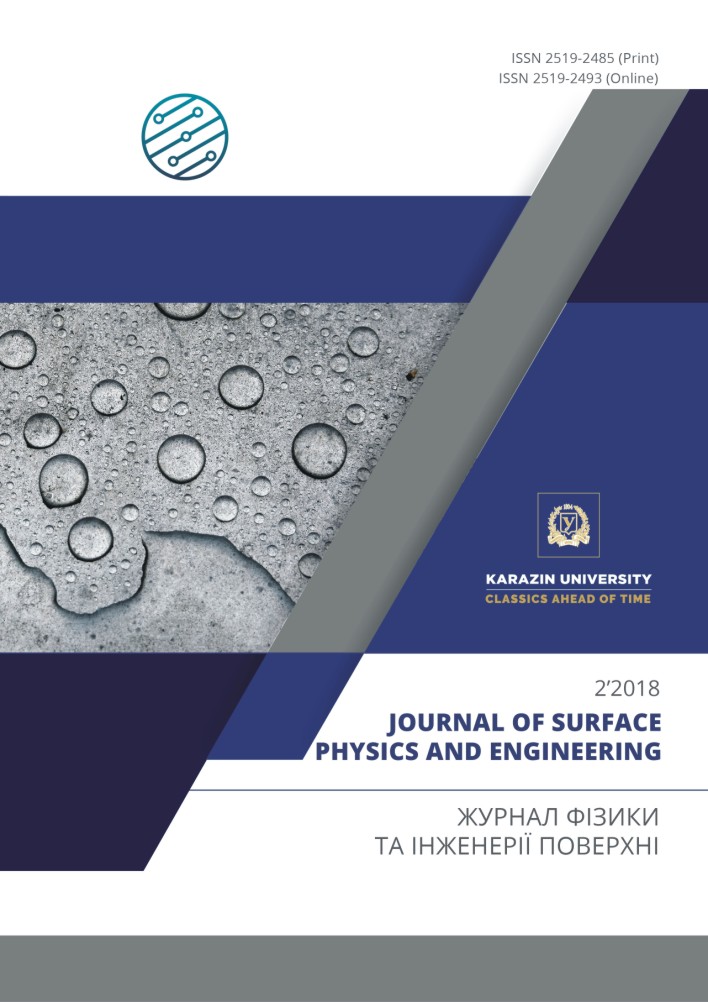The influence of long time X-ray irradiation on structure and electronic transitions of poleskiy amber and silica
Abstract
The paper deals with the effect of long-term X-ray irradiation with energies up to 60 keV on the structure and electronic transitions of poleskiy amber and silica. X-ray diffraction analysis showed that the samples had an amorphous structure without crystalline inclusions. Long-time irradiation of poleskiy amber and silica samples (absorbed dose of up to 2800 roentgens) did not lead to noticeable changes in the X-ray diffraction patterns. Electronic transitions were studied by luminescence spectrum analysis. The luminescence spectrum of silica did not change during x-ray irradiation, in contrast to the amber case. The intensity of amber light, which is associated with relaxation of electronic transition with an energy of 2.7 eV, decreased substantially, while it almost did not change for the transition with an energy of 2.25 eV.
Downloads
References
Bailey A. G. The Charging of Insulators Surfaces // J. Electrost. – 2001. – 51 – 52. – P. 82-90.
Lambert J. B., Poinar G. O. Amber: The Organic Gemstone // Accounts of Chemical Research. – 2002. – Vol. 35, No. 8. – P. 628-36. https://doi.org/10.1021/ar0001970.
Bogdasarov M. A. Mineralogy of Fossil Resins in Northern Eurasia // Geology of Ore Deposits. – 2007/ - Vol. 49, No. 7. P. 630-37. https://doi.org/10.1134/S1075701507070215.
Evans R. D. Technique for the Determination of the Radioactive Content of Liquids // Review of Scientific Instruments. – 1933. Vol. 4, No. 4. P. 216. https://doi.org/10.1063/1.1749104.
Pillai P. K. C., Goel M. Photoelectrets and Their Applications // Phys. Stat. Sol. – 1971. – Vol. 9 (A), No. 6: P. 9-23.
Guo J., Melançon C. E., Lee H. S., Groff D., Schultz P. G. Evolution of amber suppressor tRNAs for efficient bacterial production of proteins containing nonnatural amino acids // Angewandte Chemie – International Edition. – 2009. – 48, no. 48. – P. 9148-51
Gaidukovs S., Lyashenko I., Rombovska J., Gaidukova G. Application of Amber Filler for Production of Novel Polyamide Composite Fiber // Textile Research Journal. – 2015. – Vol. 86, No. 20. - P. 2127-2139.
Li L., Yang X., Gao J., Tian H., Zhao J., Hagfeldt A., Sun L. Highly Efficient CdS Quantum Dot-Sensitized Solar Cells Based on a Modified Polysulfide Electrolyte // J Am. Chem. Soc. – 2011. – Vol. 133, No. 22. – P. 8458-60.
Pipatmanomai S., Islas C. A., Suelves I., Herod A. A., Dugwell D. R., Kandiyoti R. Pyrolysis of Baltic Amber in a Wire-Mesh Pyrolysis Reactor: Structural Comparison of the Tars with Amber Extracts in NMP // Journal of Analytical and Applied Pyrolysis. – 2001. – Vol. 58-59. – P. 299-313.
Mills J. S., White R., Gough L. J. The Chemical Composition of Baltic Amber // Chemical Geology. – 1984. – Vol. 47, No. 1-2. P. 15-39.
Bellani V., Giulotto E., Linati L., Sacchi D. Origin of the Blue Fluorescence in Dominican Amber // J. Applied Phys. – 2005. – Vol. 97. – P. 016101.
Shedrinsky A. M., Grimaldi D. A., Boon J. J., Baer N. S. Application of Pyrolysis-Gas Chromatography and Pyrolysis-Gas Chromatography/Mass Spectrometry to the Unmasking of Amber Forgeries // Journal of Analytical and Applied Pyrolysis. – 1993. Vol. 25, No. – P. 77-95.
Vandenabeele P., Grimaldi D. M., Edwards H. G. M., Moens L. Raman Spectroscopy of Different Types of Mexican Copal Resins // Spectrochimica Acta - Part A: Molecular and Biomolecular Spectroscopy. – 2003. – Vol. 59, No. 10. – P. 2221-29.
Beck C W. Spectroscopic Investigations of Amber // Applied Spectroscopy Reviews. - 1986. – Vol. 22, No. 1. – P. 57-110. https://doi.org/10.1080/05704928608060438.
Pakutinskiene I., Kiuberis J., Bezdicka P., Senvaitiene J., Kareiva A. Analytical Characterization of Baltic Amber by FTIR, XRD and SEM // Canadian Journal of Analytical Sciences and Spectroscopy. – 2007. – Vol. 52, No. 5. – P. 297-304. http://cat.inist.fr/?aModele=afficheN&cpsidt=13727034.
Savkevich S. Physics Chemistry Physical Methods Used to Determine the Geological Origin of Amber and Other Fossil Resins; Some Critical Remarks // Phys. Chem. Minerals. – 1981. Vol. 7. – P. 1-4.
Lambert L. B., Frye J. S., Poinar G.O. Amber From The Dominican Republic: Analysis By Nuclear Magnetic Resonance Spectroscopy // Archaeometry. – 1985. – Vol. 27, No. 43. – P. 1-4.
Sun T. T., Kleismantas A., Nyunt T. T. et al. Burmese amber from Hti Lin // 34-th IGC2015-Vilnius, Lithuania, 2015.
Czechowski F., Simoneit B. R. T., Sachanbinski M., Chojcan J., Wolowiec S. Physicochemical Structural Characterization of Ambers from Deposits in Poland // Applied Geochemistry. – 1996. Vol. 11, No. 6. – P. 811-834. https://doi.org/10.1016/S0883-2927(96)00046-7
Koltovoi N. A., Matsui B. M. Fluorescence Methods for Studying Amber // 48 Proceedings of the National Museum of Natural History. – 2013. Vol. 11. – P. 43-48.
Mysiura, I., Kalantaryan O., Kononenko S., Zhurenko V., Chishkala V., Azarenkov M. Ukrainian Amber Luminescence Induced by X-Rays and Ultraviolet Radiation // Journal of Luminescence. - 2017 Vol. 188. – P. 319-322. https://doi.org/10.1016/j.jlumin.2017.04.045.
Mysiura I., Kalantaryan O., Kononenko S., Zhurenko V., Skiba R., Avotin S., Rokhmanov N. Luminescence of quartz glass induced by X-rays // Journal of Surface Physics and Engineering. – 2016. Vol. 1, No. 3. – P. 282-88.
Salh R. Defect Related Luminescence in Silicon Dioxide Network: A Review // Crystalline Silicon: Properties and Uses. - 2011. – P. 135-172. https://doi.org/10.5772/35404.
Zhurenko V., Kalantaryan O., Kononenko S., Mysiura I., Barannik E. Influence of He+ Long-Time Irradiation on Silica Luminescence Spectrum // Nuclear Instruments and Methods in Physics Research, Section B: Beam Interactions with Materials and Atoms. – 2017. Vol. 407. – P. 5-9. https://doi.org/10.1016/j.nimb.2017.05.038.




